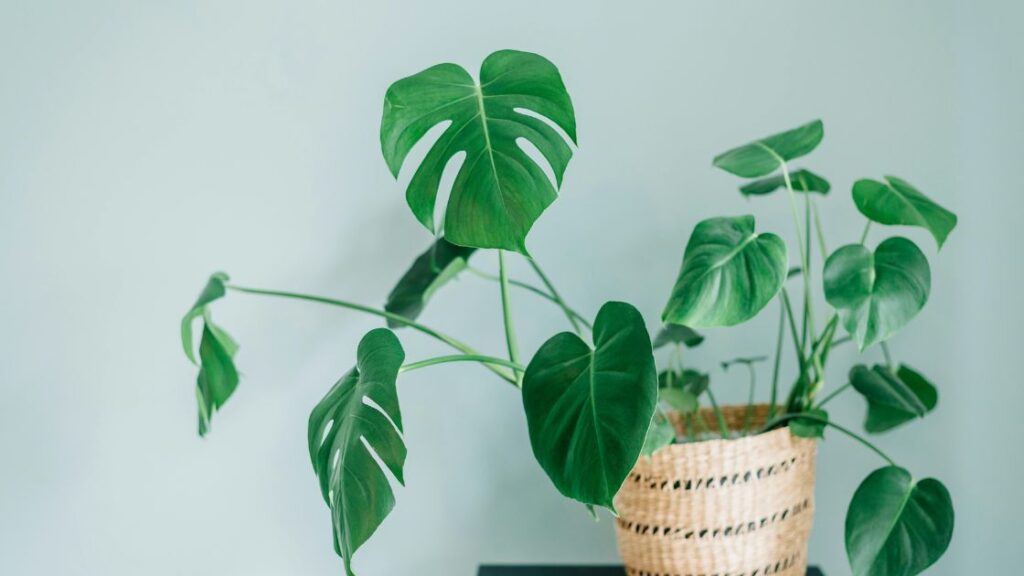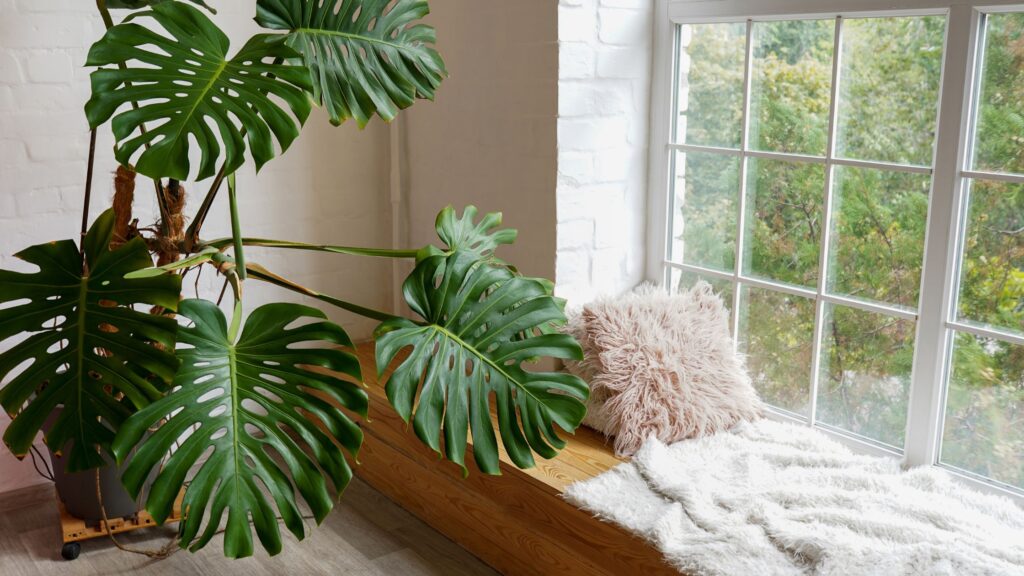This genus of flowering plants, Monstera, is native to tropical parts of the Americas and has roughly 59 species. also commonly known as the Swiss cheese plant or split-leaf philodendron. Monstera plants are popular as ornamental houseplants due to their distinctive foliage. and they are appreciated for their air-purifying qualities, making them a popular choice for indoor greenery.

Types of Monstera
Here are the names of some common types of Monstera :
- Monstera ‘Albo Variegata
- ‘Thai Constellation
- Monstera pinnatipartita
- Monstera obliqua
- Monstera adansonii
- Monstera deliciosa
Benefits of Monstera
Monstera plants offer a variety of benefits beyond just their beautiful looks. These are just some of the priority advantages.
Air Purification: Monstera acts as a natural air purifier, helping to remove common household toxins like formaldehyde and benzene from the air.
Boosts Humidity: Monstera plants release moisture vapor through transpiration, which can help increase your home’s humidity levels. This is especially beneficial in drier climates or during winter when indoor air can dry and itchy.
Low Maintenance: Monstera plants require little maintenance, which makes them an excellent option for novices or people with busy lifestyles. They don’t require frequent watering or constant attention and can tolerate various light conditions.
Beautiful Foliage: Monstera plants are known for their stunning foliage, with large, glossy leaves that come in various shapes and sizes depending on the species. They can add a touch of the tropics to any space and make a bold visual statement.
Symbolism: In some cultures, Monstera is symbolic of longevity and respect. They can be a meaningful gift or a way to bring positive energy into your home.
Propagation: Monstera plants are relatively easy to propagate through stem cuttings, making them a cost-effective option for expanding your plant collection or sharing with friends and family.
Disadvantages of Monstera

Toxicity: Monstera plants contain calcium oxalate crystals, which can be toxic if ingested by pets or humans. If you have children or curious animals, Monstera may not be the safest choice, or you’ll need to place it out of reach.
Light Requirements: Monstera prefers bright, indirect sunlight. If your home doesn’t have enough natural light, you may need to supplement with grow lights
Slow growth: While Monstera plants are known for their lush foliage, they can be slow-growing, especially in less-than-ideal conditions.
Maintenance: While generally easy to care for, Monstera still requires regular watering, pruning, and occasional cleaning.
Pest Prone: Monstera can be susceptible to common houseplant pests like spider mites, mealybugs, and scale. These can be challenging to eradicate if not caught early.
Monster care
Light: Monstera plants prefer bright, indirect light. Avoid placing them in direct sunlight, as this can lead to sunburn or leaf damage.
Temperature: Maintain room temperature between 60-80 degrees Fahrenheit (15-27 degrees Celsius) for optimal Monstera growth. Protect them from cold drafts during winter months, and avoid sudden temperature fluctuations.
Soil: Plant your Monstera in well-draining potting soil that retains moisture but does not become waterlogged. It works well for combining sand, perlite, and peat moss. Report your Monstera plant every 1-2 years as it outgrows its container.
Pruning: Remove any dead, yellowing, or damaged leaves regularly to promote overall plant health. You can also prune your Monstera to control its size and shape or to encourage bushier growth.
Propagation: Monstera plants can be propagated easily through stem cuttings. Simply cut a healthy stem with a node and aerial root, place it in water or moist soil, and wait for roots to develop before transplanting it into a pot.
Propagation of Monstera
- Pick a robust stem: Select an older stem that has several nodes and leaves. Nodes are the points on the stem where leaves emerge, and roots will develop from these nodes during propagation.
- Prepare the cutting: Using a clean, sharp knife or pruning shears, make a clean cut just below a node. Your cutting should ideally be around 6 to 12 inches long, with at least one or two nodes.
- Place the cutting in water: Fill your jar or vase with water, ensuring the node (and ideally any aerial roots) is submerged.
- Position the jar: Place the jar in a location with bright, indirect sunlight.
- Change the water: Refresh the water every 3-4 days to prevent bacterial growth.
- Wait for roots: Be patient! Root growth can take several weeks. Once the roots reach 1-2 inches in length, your Monstera cutting is ready for potting in soil.
Repotting of Monstera
Repotting your Monstera every 1-2 years, or when it shows signs of being rootbound, is essential for its continued health and growth. Here’s a breakdown of the repotting process for Monstera:
Watering: Water your Monstera thoroughly a day or two before repotting. This loosens the soil and makes the plant easier to remove from the pot.
Prepare the new pot: Fill the new pot with fresh potting mix, leaving enough space at the top for the plant and watering. If using a support pole, position it in the center of the pot before adding soil.
Removing the Monstera: Gently tip the pot on its side and slowly tap or squeeze the sides of the container to loosen the root ball. Slowly remove the plant from the pot.
Root inspection (optional): Briefly inspect the roots. You can prune away any dead, brown, or mushy roots using sharp shears. Avoid cutting healthy white roots.
Positioning in the new pot: Place the Monstera in the new pot, ensuring the base of the plant (where the stem meets the roots) is at the same level it was in the old pot. If using a support pole, carefully position the stem against it.
Filling the pot: Gently fill the remaining space around the root ball with fresh potting mix, ensuring no air pockets remain. Tamp down the soil lightly to secure the plant.
Watering: Water the Monstera thoroughly until water drains freely from the pot’s drainage holes.
Post-repotting care: Place your repotted Monstera in its usual spot with bright, indirect sunlight. Avoid overwatering in the coming weeks as the roots establish themselves in the new pot.
Monstera Disease
Monstera plants, while generally easy to care for, can still be susceptible to a few common diseases.
Root rot: Root rot is a fungal disease caused by overwatering and poorly draining soil. Symptoms include wilting, yellowing, or browning leaves, and mushy or blackened roots.
Leaf spot: Leaf spot is a fungal or bacterial disease characterized by dark spots or lesions on the leaves. These spots may vary in color and size and can eventually cause the leaves to yellow and drop. To manage leaf spots, remove and destroy affected leaves, improve air circulation around the plant, and avoid overhead watering.
Powdery mildew: Powdery mildew is a fungal disease that appears as a white powdery substance on the leaves and stems. Over time, it might weaken the plant and thrive in humid environments.
Bacterial blight: Bacterial blight causes dark, water-soaked lesions on the leaves, which may eventually turn yellow or brown. It can spread rapidly in wet or humid conditions and through contaminated pruning tools.
Pest infestations: Monstera plants can attract pests such as spider mites, aphids, mealybugs, and scale insects. These pests feed on the plant’s sap, causing wilting, yellowing leaves, and stunted growth.
Monstera Vasthu
In Vastu Shastra, an ancient Indian architectural science, plants, including Monstera, hold significance as they are believed to influence the energy within a space. While there may not be specific guidelines for Monstera plants in Vastu,
Here are some general Vastu tips for placing plants like Monstera:
Placement: Monstera plants can be placed in various areas of the home, but they are particularly suitable for the southeast corner of the east side of a room.
Avoid placing in the bedroom: In Vastu, it’s generally recommended to avoid placing plants, including Monstera, in the bedroom. Plants release carbon dioxide at night, which may disrupt sleep according to Vastu principles.
The plant is believed to strengthen relationships. Vastu also places importance on positive relationships within the home.
Well-maintained plants: Ensure that your Monstera plants are healthy and well-maintained. Dead or withering plants can attract negative energy according to Vastu principles.
Monstera Plant for Pets
while they are not classified as toxic, ingestion of any plant material can still cause gastrointestinal upset in pets.
To reduce the possibility that your dogs will consume plants:
- Place plants out of reach: Keep Monstera plants in areas where pets cannot easily access them, such as on shelves or hanging planters.
- Train your pets: Train your pets to avoid chewing on plants or provide alternative chewing toys to distract them.
- Supervise: Monitor your pets when they are around plants, especially if they are prone to chewing or exploring.
- Choose pet-safe plants: If you have pets that like to nibble on plants, consider choosing pet-safe plants that are non-toxic if ingested.
How to buy Monstera
Check local nurseries and garden centers: Visit local nurseries or garden centers in your area, as they may offer Monstera plants at more affordable prices compared to specialty plant stores.
Online marketplaces: Browse online marketplaces such as Craigslist, Facebook Marketplace, or local buy/sell/trade groups for people selling Monstera plants.
Monstera Names In other languages
- Spanish: Monstera deliciosa
- French: Monstera deliciosa
- German: Monstera deliciosa
- Italian: Monstera deliciosa
- Portuguese: Monstera deliciosa
- Dutch: Monstera deliciosa
- Russian: Монстера вкусная (Monstera vkusnaya)
- Japanese: モンステラ・デリシオーサ (Monsutera derishioosa)
- Chinese (Simplified): 美味龙 (Měi wèi lóng)
- Korean: 몬스테라 델리시오사 (Monseutera delleosiossa)
- Telugu: మొన్స్టేరా
- Hindi: मोन्स्टेरा
- Kannada: ಮೊನ್ಸ್ಟೆರಾ
Conclusion
Monstera plants, known for their striking foliage and tropical appearance, are popular choices for indoor greenery. these plants offer numerous benefits such as air purification, aesthetic appeal, and ease of care.
FAQs of Monstera
1. How big will my Monstera plant grow?
Ans: The size of a Monstera plant can vary depending on factors like genetics, growing conditions, and care provided. Monstera deliciosa, for example, can grow several feet tall and wide indoors under optimal conditions.
2. How can I make my Monstera grow faster?
Ans: To encourage faster growth, provide your Monstera with bright, indirect light, warm temperatures, and high humidity.
3. Can I propagate my Monstera plant?
Ans: Yes, Monstera plants can be propagated easily through stem cuttings. Simply take a healthy stem cutting with a node and aerial root, place it in water or moist soil, and wait for roots to develop before transplanting it into a pot.
4. Is Monstera a good houseplant?
Ans: Monstera plants offer a combination of aesthetic beauty, air-purifying qualities, ease of care, and versatility, making them a popular choice for indoor greenery and enhancing the ambiance of homes.



Fantastic goods from you, man. I have understand your stuff previous to and you are just too great. I actually like what you have acquired here, certainly like what you are stating and the way in which you say it. You make it entertaining and you still take care of to keep it sensible. I can’t wait to read much more from you. This is actually a tremendous website.
Magnificent site. Lots of useful information here. I am sending it to several friends ans also sharing in delicious. And certainly, thanks for your sweat!
tq